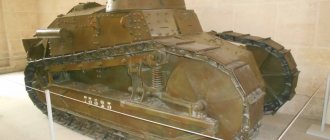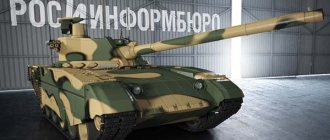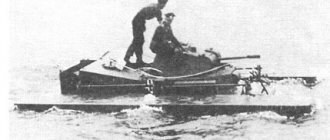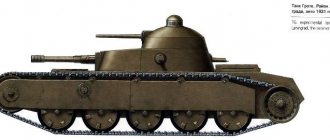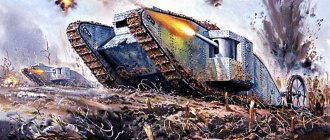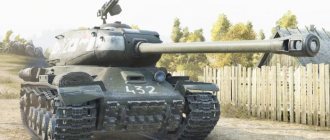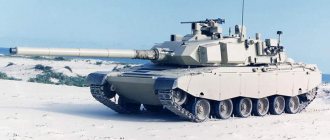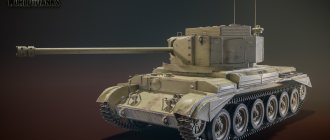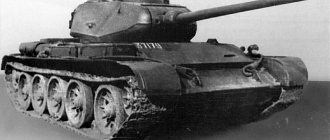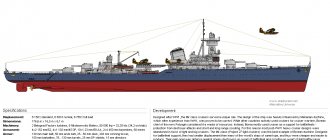Home » Real story » History of Wars » Conditionally fit. Light tanks Renault R 35 in the hands of the Wehrmacht
History of WarBooks on the history of tanks
boroda 07/23/2019 1718
13
in Favoritesin Favoritesfrom Favorites 9
Being the most popular French tank by the spring of 1940,
the Renault R 35 also turned out to be the Wehrmacht's most popular armored tank. Often these vehicles fell into the hands of the Germans either intact or so slightly damaged that they quickly returned to service. In total, from 800 to 840 Renault R 35 fell into the hands of the Germans - a more than impressive figure. Another thing is that the tank, designated Panzerkampfwagen 35R 731(f), did not improve its combat qualities due to the change of name and owners. For this reason, his career in the German army, although long, was very ornate. In the hands of its new owners, it had to be a self-propelled artillery mount, a tow truck, an artillery tractor, and a crane.
Renault R-35 Light tank
Official designation: Char leger modele 1935 R Alternative designation: Renault ZM, Renault R-35 Start of design: 1933 Date of construction of the first prototype: 1934 Stage of completion of work: during 1936-1940. 1630 tanks were built.
After a series of failures associated with attempts to modernize the FT-17 tank, Renault was forced to admit that the previously chosen path was ineffective. Issued between 1918 and 1930. tanks M24\25, M26\27 and NC27 did not have the expected success and were produced in single batches, not exceeding 100 units in total. The French army was favorable only to the Renault D1 and D2 models, which belonged to the middle class of tanks. Thus, the only mass-produced light tank was still the FT-17. The first attempt to correct the situation was made back in 1926, but then none of the submitted tanks passed the competition. The second time the French military department returned to this problem was only in 1933, when the most likely opponents (USSR and Germany) began building light tanks in the hundreds. Even then, the requirements for a light infantry support tank looked downright underestimated:
weight - no more than 6 tons;
crew - 2 people;
armament - 2 machine guns or a small-caliber cannon;
reservation - at least 30 mm;
average speed is 8-10 km/h.
However, the French were completely sure that the infantry support tank should be exactly like this. This was facilitated by the military doctrine adopted many years ago, which made tanks an “appendage” of the infantry and deprived them of freedom of action. According to the French General Staff, offensive actions could only be local in nature and the main emphasis was on creating a strong defense on the Maginot Line, while the borders with Belgium and Switzerland remained with purely symbolic cover. In other words, the Army was hoping to get another FT-17, only with more powerful armor and a higher top speed. At first, 14 companies took part in the competition for such an order, which was so profitable in all respects, but in 1934, 7 of them were retained, and only four were given the order for the production of prototypes.
Renault remained one of the regular participants in such “competitions,” this time presenting a completely new design that had nothing in common with the FT-17.
First of all, a new chassis was used, also used on the AMC 35 light tank. On each side it consisted of a drive wheel, a cast idler, five rubberized single road wheels and three rubberized support rollers. The four front rollers were interlocked in two “scissor-type” carts, which consisted of two balancers hinged to each other, in the lower part of which there was a roller, and the upper parts were hinged together through an elastic element, which was a rubber spring. The fifth roller was suspended on a single balancer, the spring of which was connected at its other end to the tank hull. The tank's caterpillar consisted of 126 steel single-ridge tracks with a width of 260 mm and a pitch of 65 mm.
The new tank hull was assembled from cast sections with armor thickness from 10 to 35 mm. The front part had rational angles of inclination of the armor plates, but due to the strong shift to the center, the fighting compartment felt very cramped. A traditional three-leaf hatch was made in the front sheets to accommodate the driver. The tank commander sat down and left the vehicle through an opening in the roof of the turret.
The armament, unfortunately, remained at the level of tanks of the First World War. The hexagonal cast turret with smoothed corners carried only two 7.5 mm Chatellerault machine guns.
Observation equipment consisted of binocular viewing devices (“episcopes” - paired viewing windows, closed on the inside with protective glass and can be closed from the outside with an armored shutter) and viewing slits.
The tank's power plant consisted of a carburetor 4-cylinder Renault engine with an output of 82 hp. at 1850 rpm, shifted to the right of the longitudinal axis. To the left of it, one above the other, there were two fuel tanks of 150 liters each (according to other sources - one 166-liter tank). A radiator and other components of the cooling system were installed behind them.
The transmission was made according to a completely standard design. It consisted of a 4-speed manual gearbox, a two-disc main dry friction clutch, a driveshaft (which ran along the right half of the fighting compartment and connected the gearbox to the rest of the transmission located in the frontal part), two single-stage final drives, a main brake and a turning mechanism consisting from a double differential and two band brakes, used only for turning the car.
Testing of the first prototype of the tank, called Renault ZM
, began in 1934, and already on December 20 it was presented to the state commission. It must be said that, despite the outdatedness of the technical specifications, the French military expected more. The Renault tank had low cross-country ability off highways and dirt roads, the fighting compartment was still cramped, and the combat weight was more than 10 tons, significantly exceeding the specified limit. The military was also not satisfied with the composition of the Renault ZM's weapons. The tank's maximum speed was 20 km/h with a highway range of 130 km. On the ground, the speed decreased to 14 km/h, and fuel consumption increased to 212 liters per 100 km.
The cost of one R-35 was not small, amounting to 1,400,000 French francs (32,000 US dollars) in 1935 prices, of which 190,000 was the cost of the turret without weapons and internal equipment. However, the army adopted the R-35 under the designation Char leger modele 1935 R
(or
Renault R-35
), but with the condition of modernization during production. One of the reasons for such a step was the obvious lag of the French tank industry behind the world level and its inability to quickly organize the production of modern equipment in large volumes. The first order for 300 tanks was received on April 29, 1935, and the first production tank was received on June 4, 1936.
Production tanks were distinguished by a modified hull-part hull design and a new solid-cast turret of the ARKh type. The thickness of the side walls of the tower with an angle of inclination of 32° was 40 mm, the frontal part was 43 mm, and the roof was 25 mm. A rotating armored dome with a ventilation hatch, a double hatch for crew landing and a hatch for flag signaling were installed on the roof. Accordingly, tanks began to be equipped with full-fledged machine gun and cannon weapons. The turret was equipped with an old 37-mm SA18 semi-automatic cannon with horizontal rotation angles from -5 to +5°, and vertical rotation angles from -11 to +19°. Aiming and firing the cannon was carried out by the tank commander using a shoulder rest. To the left of the gun was a telescopic optical sight, to the right was a 7.5 mm Chatellerault coaxial machine gun. The ammunition consisted of 2,400 rounds of ammunition and 100 shells.
The tank's hull was multi-sectional and assembled from rolled armor plates with a thickness of 10 to 40 mm. Technologically, it was divided into the following components: lower, front, upper, aft (solid armor castings) and bottom. To increase rigidity, additional spacers made of pipes and angles were welded to the inside of the bottom. The frontal armor plates were installed at an angle of 23-24°. In the bow of the hull there was a hatch for the driver, in the middle there was a hatch for access to the transmission units, in the aft there was a hatch for access to the engine. In some cases, a “tail” of a truss structure could be attached to the stern of the tank, which was used to overcome ditches and trenches more than 2 meters wide. However, most of the tanks produced did not receive it.
Subsequently, Renault signed several more contracts, which brought the total number of tanks ordered to 2300. During production from the end of 1935 to June 1940. the total number of R-35 tanks of all modifications produced was 1,670 units, although a number of sources bring their number to 1,685.
During operation, R-35 tanks were highly valued only for their excellent armor protection. The frontal and side armor of the Renault was difficult to penetrate with shells from German 37-mm PaK 35/36 anti-tank guns, and French 25-mm anti-tank guns could only penetrate it at distances of up to 100 meters. At the same time, the speed and cross-country ability of the R-35, its ability to overcome obstacles and standard weapons were rated extremely low. In order to increase the combat effectiveness of the tank, Renault took a number of steps that led to the creation of prototypes.
An extended chassis was tested on one of these vehicles. The increase in length was achieved by introducing a sixth track roller with independent suspension, which was installed behind the second bogie. Now the R-35 could overcome ditches and trenches up to 2.5 meters wide, but maneuverability had deteriorated somewhat. This sample had to be left at the experimental level.
Since 1936, work has begun to rearm and improve the tank's security. Instead of the standard ARX turret on the R-35, it was proposed to install a turret from the FCM 36, which had a larger internal volume. The experiment was successful, but overall this rearrangement did not provide any advantages. As a result, instead of the outdated SA18 gun, a new 37-mm SA38 cannon was installed in the new APX-R1 turret, which had much better destructive properties, coaxial with a 7.5-mm MAC31 “Reibel” machine gun. The first experiments were carried out back in 1935, and the following year new towers began to be installed on the R-35. The upgraded tanks received the designation R-39
, though they produced only a few of them - only 247 units. It would also be nice to install radio stations, but in addition to several tanks from the 507th Tank Regiment (507e Regiment de Chars de Combat).
A more radical modernization was carried out in 1938 by AMX and led to the creation of the R-40 tank. Unlike the R-35, these vehicles still received a multi-roller chassis, ARX-R1 turrets with SA38 cannons and radio stations, but they were only produced for a very short time.
At the beginning of 1940, a series of experiments on radio-controlled tanks was carried out. One of the serial R-35s was used as a command vehicle, on which a large box-shaped conning tower was installed instead of a turret, which in turn entailed a change in the hull design. To the right of the driver's seat and in the place of the former fighting compartment, radio equipment with two antennas was installed. The crew of the commander's R-35 remotely controlled the converted FT-17 tank. The experiments were quite successful, but due to the outbreak of the war they could not be brought to the proper level.
As mentioned earlier, the R-35 and N-35\N-39 tanks were planned to replace the completely outdated Renault FT-17\FT-18 and its modifications, which by the mid-1930s. were present in significant quantities. Ideally, the new vehicles should have become standard infantry support tanks from the summer of 1936, but even by the beginning of 1940 this program could not be completed.
As of September 1, 1939, the French army had 975 R-35 tanks out of 1,075 produced, but not all of them were in combat-ready condition. As follows from archival data, 765 tanks were distributed among tank units, 49 were used for crew training, 45 were sent to colonies (Algeria, Tunisia) and another 33 were in warehouses in partially incomplete condition.
The configuration of the French tank units was very interesting. In accordance with instructions dating back to the First World War, these units had only the tanks themselves and support vehicles (technical, repair, fuel tankers). Infantry and artillery were not assigned to them and acted separately. On May 10, 1940, R-35 tanks were distributed among eight armies and operated in the following units:
Ie Armee - GBC 515 (35еBCC), GBC 519 (39еBCC);
IIe Armee - GBC 503 (3eBCC);
IIIe Armee - GBC 511 (5eBCC and 12eBCC), GBC 520 (23eBCC), GBC 532 (43eBCC);
IVe Armee - GBC 502 (20еBCC and 24еBCC), GBC 504 (1е0BCC);
Ve Armee - GBC 501 (1rBCC and 2eBCC), GBC 508 (21eBCC and 34eBCC);
VIIe Armee - GBC 510 (9eBCC and 22eBCC);>
VIIIe Armee - GBC 506 (16eBCC and 17eBCC); I
Xe Armee - GBC 518 (6eBCC and 32eBCC);
Each tank battalion had 40 combat tanks and 5 training tanks.
Already during the war, 300 newly arrived tanks were sent to the 2e VSS, 4e VSS, 44e VSS (all were part of the 4e DCR - Division Cuirassee de Reserve), as well as to the 40e VSS and 48e VSS (reformed 2e DCR). The last two battalions had a mixed complement of tanks - a total of 31 R-35 and 59 improved AMX R-40, although in terms of combat qualities both types of tanks were almost equivalent. In addition, 17 R-35 and 24 R-40 were at the disposal of the 1st and 2nd tank battalions of the 10th Polish armored brigade, and in Syria there were another 50 tanks as part of the Bataillon de Chars Syrie. The total number of R-35 and R-39 tanks is estimated at 1070 units.
The combat operations of the 4e DCR, commanded by General Charles de Gaulle, did not go very well. Taking command on May 11, he discovered that the division was incomplete - it had only 215 tanks (120 R-35, 45 D2 and 50 B1bis). But the worst thing was its technical equipment. The division's only infantry unit was a motorized infantry battalion transported by bus. There were practically no radio stations in the division, and orders were delivered to units by cyclists. The division's artillery consisted of several reserve units. Supply and maintenance services were virtually non-existent.
Despite this, on May 16, the division attacked the flank of the German tank wedge (1st, 2nd and 6th Panzer Divisions) in the Montcornet area. De Gaulle acted cautiously, trying with all his might to delay the enemy in order to create a reserve of time to regroup forces. Using the cavalry “pounce” method, the French struck in unexpected places, but all the efforts of the 4th DCR were in vain. Having lost many tanks on the march (due to a lack of fuel, spare parts and air strikes), the division was subsequently stretched piecemeal and by mid-May it ceased to exist as a full-fledged tank formation.
After heavy defeats in Belgium and the Somme, French troops gradually began to roll back inland. In fact, at this moment there was no centralized command and control of the troops and each tank group acted independently, for the most part conducting rearguard battles. The chosen tactics of “foci of resistance,” when there was no continuous line of defense and the entire defense was built around populated areas, did not justify itself at all. So, on June 10, in the battle near Annelles, the German 1st Panzer Division was able to oppose the French with 40 R-35s from the 10th VSS, several heavy B-1bis tanks from the 3/41st VSS and units of the 7th DLM. In total, the group had 65 light tanks, but only 20 of them (N-39) had modern SA38 guns. In turn, the Germans had 258 tanks (18 command tanks based on Pz.I, 52 Pz.I, 98 Pz.II, 58 Pz.III and 40 Pz.IV) and 56 armored vehicles. However, the main anti-tank fist of 1 PzD consisted of 9 Flak18 anti-aircraft guns of 88 mm caliber and 24 105 mm leFH18 howitzers. Thus, the outcome of the future battle was predetermined before it began. The first battle of 13 R-35s from the 2/10th VSS with German medium tanks ended in the complete defeat of the French company. During the first minutes of the battle, 9 R-35s were shot down, and the remaining 4 had to retreat, with only 1 tank proving suitable for further action. The fire of the French 37-mm SA18 guns turned out to be effective only from an extremely close distance of 100 meters, but the Renault crews were not able to destroy a single German tank. By the end of the day, out of 27 combat-ready R-35s that were part of the 2nd and 3rd companies of the 10th VSS, only 7 vehicles retained their combat capability (10 were destroyed and 10 were damaged), the total number of French tanks was reduced to 41. The French were saved from complete defeat... the Germans stopped their counterattacks while waiting for fuel.
The last major battle for the tank battalions was an attempt to counterattack the Suip River, where on June 11-12, 50 tanks from the 3rd DCR were brought into battle. Of course, such small forces could not withstand the blow of the German 1st Panzer Division, which defeated the French units and rushed to the rear. Until June 22, French tanks, scattered among individual units, fought holding battles until a truce was announced.
Until this point, the crews of 12 R-35s chose to cross the Swiss border and surrender to local authorities. The tanks were soon incorporated into the Swiss army and were used until the late 1940s. mostly for training.
For France, the end of the war resulted in an act of surrender and the almost complete disbandment of the already small remnants of tank forces. The Vichy government was allowed to keep a number of tanks for the defense of the mother country and colonies, while most of them were confiscated by the Germans.
For example, two tank battalions (63rd VSS with 45 tanks and 68th VSS with 50 tanks) remained in Syria in 1940 to maintain order in this troubled colony. Subsequently, in 1941, they took part in battles against the British Commonwealth forces, which invaded the Middle East in response to France providing its airfields for German and Italian aircraft. After a short resistance, the French surrendered, and the captured R-35s were transferred to the Free French IeCCS and then used in North Africa during Operation Torch (November 1942). In addition, after the signing of the surrender, the new French command sent 30 tanks to Morocco.
In the post-war period, the surviving R-35s were transferred to the gendarmerie, where they were rearmed with SA38 guns, bringing them to the R-39 variant. Here they were used until 1951; the R-35 was not finally replaced by the American M4 “Sherman”.
In 1938, the Polish government, concerned about the insufficient rate of production of light tanks 7TP, as well as the speed of their modernization (project 9TP), decided to turn to its old ally with a proposal to purchase two Renault R-35 tanks (Renault Type ZM) for comprehensive testing. Although France itself acutely felt the need to modernize its tank fleet, Renault considered it possible to satisfy the request of the Polish side.
The tests carried out disappointed Polish military experts. The tanks showed extremely poor maneuverability, had low speed and were armed with the long-obsolete 37-mm Puteaux SA18 cannon. The only advantage of the R-35 was their armor protection, but it only saved them from being hit by bullets of any caliber and armor-piercing shells from guns with a caliber of no more than 37 mm. Comparing these facts, the Polish army abandoned the R-35, intending to purchase more powerful medium tanks SOMUA S-35, but these plans were not destined to come true.
The program for modernizing the armored forces, by that time, was in its initial stages, and the French side could begin deliveries of the S-35 no earlier than 1940. Then it was decided, as an emergency measure, to purchase 100 light tanks R-35, which were available in sufficient quantities quantity. The agreement was signed in April 1939, and in July the first 49 (according to other sources 50) tanks arrived in Poland.
Together with three Hotchkiss H-35s, also purchased for testing, the R-35s became part of the 12th Armored Battalion stationed in Lutsk. When the war with Germany began, French tanks were consolidated into the 21st light tank battalion, which became part of the reserve of the army's main command. Anticipating an imminent defeat, in early September this unit was given the task of retreating to the Polish-Romanian border. A few days later, on September 17, an evacuation order was issued. At this point the battalion was divided into two parts. The most numerous of them (34 vehicles) went to Romania, where they were interned. The second group (about 10 vehicles) was transferred to the Operational Group “Dubno” and took part in the battles near the cities of Krasne and Kamionka Strumilowa. In addition, six tanks were also transferred to the 10th Motorized Cavalry Brigade.
At the end of the war, not a single Polish R-35 was captured in combat condition. All of them failed due to combat damage or technical reasons. Apparently, the Germans did not restore the captured R-35s captured in Poland. The tanks of the second batch (50 units) were not sent from France and were sent to Tunisia in October 1939.
In addition, exports included 100 tanks for Turkey, 200 for Romania and 54 for Yugoslavia. It was not possible to fulfill these orders in full.
The Romanian army, having ordered the R-35 back in 1939, received only 41 tanks - the rest had to be left in France, in view of that country's entry into the war and its subsequent occupation. An unexpected but pleasant “surprise” was the appearance of Polish R-35s from the 21st battalion. Immediately after crossing the border, the tanks and their crews were interned. The tankers were subsequently released, and the R-35, after minor repairs, was included in the 2nd Tank Regiment of the 1st Tank Division, the formation of which began on April 17, 1941.
R-35 tanks took part in hostilities against the USSR almost from the first day of the war, but the methods of their use and crew training still left much to be desired. In the period from June 22 to August 20, 1941, irretrievable losses amounted to 16 vehicles (8 burned out) and another 9 were seriously damaged and could not be repaired. Formally, the Romanians had 45 R-35s left, but 26 of them were under repair and only 19 could take part in further battles. The last major battle in which the R-35 participated was the Battle of Odessa, which ended in October. Having collected the surviving French tanks, which showed low combat effectiveness, the Romanian command took them to the rear and used them for most of the remaining time for training and security purposes.
In February 1944, when there was a clear threat of a Soviet invasion of Romania, a mechanized group was sent to help German formations, which included an R-35 company. A little later, in August, the Victor Popescu combat group received a platoon of French tanks, which also included a company of R-2 medium tanks (licensed copies of Czech modified Lt.vz.35) and a platoon of T-38 light tanks (also Czech-made). These units briefly took part in battles against Soviet troops near Ploesti and Iasi, until Romania signed an armistice.
According to this act, the Romanian tank forces were disbanded, with the exception of the 2nd tank regiment. As of February 1945, when the regiment was subordinated to the 27th Tank Corps, it consisted of one reconnaissance company (8 armored vehicles and 5 armored personnel carriers), a tank battalion (8 Pz. IV) and two companies of assault guns (13 TA self-propelled guns), a battalion light tanks (2 companies of R-35 tanks - 28 units), one company of T-38 (9 tanks) and a self-propelled gun battery of 5 TACAM R-2. There is also a statement that all remaining R-35s were rearmed with Soviet 45 mm 20K tank guns. During the battle on the territory of Czechoslovakia and Austria, the 2nd Tank Regiment of the Romanian Army suffered heavy losses, losing 93% of its tanks in less than three months. In particular, only in the battles in the Khron River valley on March 26 - 27, 1945, 8 R-35s were irretrievably lost, and not a single tank of this model survived until May 1945.
Only the Turkish order was fully completed. All tanks were received by the beginning of 1940 and became part of the Armored Brigade, subordinate to the 1st Army and stationed near Istanbul. In addition to the R-35, this unit was equipped with nine BA-6 medium armored vehicles, 16 Mk.VIB light tanks, and 48 T-26 light tanks model 1933. Such a “motley” composition was explained by the fact that the Turks tried to insure themselves for all occasions, but at the same time they preferred easy-to-use and inexpensive equipment. The Armored Brigade was never used in combat conditions. Soviet tanks and armored vehicles were withdrawn from service in 1942, and French tanks were withdrawn from service only after the war.
The tanks, ordered by the Yugoslav government, arrived before the start of the war and only fought for a short time. Due to the loss of control over the troops, the Germans failed to provide worthy resistance. Apparently, the Yugoslav R-35s fought their only battle on April 13-14, 1940 against units of the 11th Panzerdivision, after which the surviving vehicles were captured by the Germans.
The Germans, in total, managed to capture and requisition 843 Renault tanks of both modifications. In accordance with the designation system adopted for captured vehicles, these vehicles were named Panzerkampfwagen 35R (f)
or
Panzerkampfwagen 731 (f)
. However, the Germans were not particularly happy about this acquisition. Panzerwaffe was absolutely not satisfied with the speed of the tanks and their weapons. The gun installed on the R-35 was previously used on older FT-17s and by all indicators did not meet the requirements of modern warfare. In fact, the R-35 could more or less effectively fight only with infantry that did not have anti-tank weapons, but in no case with enemy tanks, since its ammunition did not include armor-piercing shells, and the effect of high-explosive shells was small. Thus, there were two optimal ways of using French tanks: guarding military facilities or converting them into auxiliary vehicles. In 1941-1942. The Germans converted some of the tanks into tractors, armored vehicles, and artillery transporters (110 units), some of which were actively used at that time on the Eastern Front.
The second part of the R-35 and R-39 was converted into anti-tank self-propelled guns 4.7cm PaK(t) auf Panzerkampfwagen 35R(f) ohne Turm
.
They were supposed to replace the outdated Panzerjager, manufactured on the chassis of the Pz.I light tanks, and therefore had low driving characteristics. As the name of the self-propelled gun suggests, it was equipped with a 47-mm anti-tank gun 4.7cm PaK(t) L43/4 (Czechoslovakian Skoda A-5), installed in an armored wheelhouse open at the top. Accordingly, the standard turret was dismantled and German radio equipment was installed. The first prototype of the self-propelled gun was built by February 8, 1941, and a total of 174 self-propelled guns of this version were produced. , Befehlspanzer fuer 4.7cm PaK(t) Einheiten auf Panzerkampfwagen 35R(f)
command armored vehicles , equipped with additional radio equipment, were produced. Instead of a cannon, they had one 7.92 mm machine gun. A total of 26 such machines were built.
In 1942, an attempt was made to modernize the self-propelled guns by installing a 50-mm PaK 38 anti-tank gun. The self-propelled gun was named 5cm PaK 38 auf Panzerkampfwagen 35R(f) ohne Turm and was built in a single copy. Serial production was once again hampered by the performance of the Renault chassis and the entry into service of similar vehicles.
The turrets removed from the R-35 were also used. Since 1941, they began to be installed on the Atlantic Wall as fixed firing points, but since their armament was completely preserved, one could not expect much effectiveness from such bunkers. Most likely, structures of this type were created with the aim of temporarily containing the enemy.
Here is another example of using R-35, much more successful. On the morning of February 10, 1942, in the area of operation of units of the 2nd Shock Army near the village of Bolshoye Eglino, the Germans used three captured tanks in a counterattack. Supported by a company of Renault infantry, they managed to break through the Soviet defenses. True, the machine gunners had already been cut off by strong rifle and machine-gun fire and the tank crews had to act independently. The R-35s slowly crawled into the village where they were met by a crew of a 45mm anti-tank gun. Theoretically, an armor-piercing shell could penetrate the 45-mm frontal armor of a French vehicle, but all fired shells bounced off it. As a result, the tank crushed the gun along with its crew, but was itself set on fire by the infantry that arrived. The remaining two R-35s turned back. Upon examination of the damaged tank, it was concluded that its hull and turret were shielded.
However, several R-35s were placed at the disposal of SS punitive units operating in the territory of the former Yugoslavia. At the first stage of their use, everything turned out quite well, since the Yugoslav partisans did not have heavy or anti-tank weapons. According to the recollections of participants in those battles, R-35 tanks, due to their small size and good armor, were quite suitable for operations in mountainous areas. True, with the advent of artillery and captured tanks among the Yugoslavs, the situation changed not in favor of the Germans, although the R-35 continued to be used until their complete defeat in the spring of 1945.
These tanks withstood their last battle as part of the Wehrmacht in the summer of 1944, when the Allies landed in Normandy and all combat-ready equipment was urgently pulled to the coast. Among other vehicles, including many French tanks and self-propelled guns at their base, there were 14 R-35s, which were part of the 100th Tank Battalion and subordinate to the 7th Army. On the morning of June 6, the tanks arrived at the landing site near the city of Sainte-Mere-Eglise, where, together with infantry from the 1057th Grenadier Regiment, they entered into battle with units of the American 1st Battalion of the 505th Parachute Infantry Regiment. The French tanks, as well as their crews, simply had no chance of surviving. During the battle, all R-35s were destroyed by the Americans using bazooka rocket-propelled grenade launchers.
Germany was happy to sell equipment it didn’t need very much to not very reliable allies. Most of the Renault tanks were sent to Italy, which, until the middle of the war, was not able to create a single worthy combat vehicle (with the exception of the Semovente da 75/18 and 90/53 self-propelled guns). A total of 131 R-35 units were received, which were used both in the former Yugoslavia and in Italy to protect military installations. Something to say about their combat use during 1941-1942. quite difficult, since reliable information about this has not yet been found.
Bulgaria received at least 40 tanks, but here they were mostly used as training vehicles and were scrapped after the war. As for the use of the R-35 in the Croatian army, there is no precise information on this matter. It is possible that in 1941-1942. The Germans gave the Croats several tanks of this type, which were used to fight partisan formations. In any case, not a single R-35 was included in the Croatian tank units in the spring of 1944. Nevertheless, at least one tank of this type became a trophy of the Yugoslav partisans.
During the Battle of France, some of the equipment was taken to Switzerland. Among other vehicles there were 12 R-35 tanks. In 1940, they were interned by the Swiss authorities and adopted by their own army. In the face of the threat of attack from Germany, even not so modern cars were quite a valuable acquisition (especially - absolutely free). However, the German invasion never took place, and in the late 1940s. "Renault" was sent to a well-deserved rest.
The final “chord” in the history of the R-35 was the first Arab-Israeli war. As soon as Syria gained independence, it began to work closely on creating tank forces. This, as you might guess, was not done for defensive reasons - the state of Israel, formed in the west, was literally an “eyesore” for the Arab rulers, who firmly intended to throw the Jews into the sea. As a “free gift” from the British and French, outdated but fully combat-ready tanks, including several R-35s, were left in Syria. On May 20, 1948, three vehicles were used in the attempted takeover of the Jewish kibbutz Dagania in the Galilee. Deciding that the Israeli forces were few in number and poorly armed, the Syrians boldly went on the attack. Approaching the defensive line, the tanks were met by fire from a single 20-mm anti-tank gun and Molotov cocktails, with which the Israelis set fire to all three tanks. The Syrians were forced to retreat, leaving the vehicles to the enemy, and they tried not to involve more R-35s in performing such tasks. Soon the remaining tanks were re-equipped with 40-mm British tank guns, and in the early 1950s. they were scrapped.
Currently, tanks of the R-35 modification are on display at BTT museums in Samur (France, where the R-39 is also on display), Aberdeen (USA), Yad La Chillon (Israel) and Kubinka (Russia). Another R-35 tank, knocked out near Daganiya, was erected as a monument on Israeli territory.
Sources: "Armored vehicles of France 1940" (Army series No. 16) Riga. Tornado. 1997 G.L. Kholyavsky “Complete encyclopedia of tanks of the world 1915-2000.” Harvest.Minsk \AST.Moscow. 1998 P.Danjou “Renault R35/R40”. Barbotin. Ballainvilliers. 2005 P. Touzin “Les vehicules blindes francais”, 1900-1944″. EPA. 1979 Allied Tanks of World War II: French Armor II WorldWar2.ro: Renault R-35
TACTICAL AND TECHNICAL CHARACTERISTICS OF THE LIGHT TANK Renault R-35 model 1936
| COMBAT WEIGHT | 10000 kg |
| CREW, people | 2 |
| DIMENSIONS | |
| Length, mm | 5000 (with tail) |
| Width, mm | 1850 |
| Height, mm | 2376 |
| Ground clearance, mm | 320 |
| WEAPONS | one Puteaux 37 mm L/21 SA18 cannon and one Chatellerault 7.5 mm MAC31 “Reibel” machine gun |
| AMMUNITION | 42 armor-piercing and 58 high-explosive fragmentation shells, 2400 rounds of ammunition |
| AIMING DEVICES | telescopic sight and episcopes |
| RESERVATION | hull forehead - 40 mm hull side - 40 mm hull rear - 32 mm turret forehead - 40 mm turret side - 40 mm gun mantlet - 40 mm roof - 25 mm bottom - 10 mm |
| ENGINE | Renault, carburetor, 4-cylinder, 82-85 hp; Fuel tank capacity - 166 liters |
| TRANSMISSION | mechanical type: main double-disc dry friction clutch (ferodo by ferodo), three-way four-speed (4+1) manual gearbox, driveshaft, main brake, turning mechanism (double differential and band brakes), two single-stage final drives |
| CHASSIS | (on one side) five track rollers on horizontal rubber springs (four rollers are interlocked in pairs and one with individual suspension), three support rollers, front drive and rear guide wheels, fine-linked caterpillar made of steel tracks |
| SPEED | 20 km/h on the highway 14 km/h on the country road |
| HIGHWAY RANGE | 130-140 km along the highway 80-85 km along the country road |
| OBSTACLES TO OVERCOME | |
| Elevation angle, degrees. | |
| Wall height, m | 0,50 |
| Fording depth, m | 0,60 |
| Ditch width, m | 1,50 |
| MEANS OF COMMUNICATION | radio station ER 54 mle 1938 |
Development[edit]
The development plan of 1926 foresaw the introduction of char d'accompagnement
, a cheap mass-produced light tank to replace the Renault FT from the First World War crop to make it possible for standard rifle divisions to carry out combined arms infiltration, was seen as the only viable method of modern offensive warfare left to non-motorized units.
The French army did not have the means to motorize more than a few select divisions. In 1930 this plan was replaced by a new one with more precise specifications. The first tank that was supposed to meet his requirements, the Char D1, turned out to be neither cheap nor particularly light. In 1933, Hotchkiss
offered an alternative solution, the later Hotchkiss H35.
For political reasons, this proposal was turned into the 1933 Plan,
and in August 1933 the entire French industry was invited to propose possible design options.
Fourteen companies responded (among them Delaunay-Belleville
), and five presented a prototype:
Hotchkiss
,
Compagnie Général de Construction des Locomotives
, APX, FCM and, of course, the main tank manufacturer in France: Renault.
Fearing that his rival Hotchkiss might well replace him as such, Louis Renault hastened to finish off the car; Construction soon reached such an advanced stage that changes to the June 21, 1934 specification to increase the armor thickness from 30 to 40 mm could not be implemented. On 20 December 1934 Renault was the first to deliver a prototype, with the project name Renault ZM
, to
the Commission de Vincennes
.
In the spring of 1935, this vehicle was equipped with heavier armor and a standard APX turret, which Atelier de Rueil
set from April 18 to April 25. The prototype was still undergoing testing when international tensions increased due to German rearmament. This created an urgent need for faster modernization of the French tank fleet. The ZM was to be put into production immediately. On April 29, 1935, an order was placed for 300 examples, even before the final model was completed, at a price of 190,000 French francs per hull (without weapons, without engine and turret, the total export price was about 1,400,000 francs in 1939. [ 2], which is about $32,000 by 1939 standards). [3] The first production car was delivered on 4 June 1936 and had to undergo extensive testing again as it was different from the prototype.
Links[edit]
- ^ a b White, B. T. (1983). Tanks and other armored fighting vehicles from World War II
. Books of peers. p. 91. ISBN 0-907408-35-4. - "Prices for Polish weapons before 1939". PIBWL Private Army Research Institute. Retrieved 23 February 2006.
- The price of 190,000 FF (for the entire hull only: the turret added another 100,000), although very low compared to other tanks of the era in dollars, is comparable to many similar prices in other French tank contracts. In 1935, there was severe deflation of the dollar for many years, making it very strong against the franc. Moreover, from 1936 the situation was exacerbated by a deliberate French policy of devaluation until the FF was fixed against the dollar at 43.8 to 1 on September 9, 1939. However, these exchange rates did not reflect intrinsic value: they were an artificial instrument to stimulate French exports. This explains how the French were able to produce the entire 35 rand in 1939 for about 500,000 French francs: the real cost of the materials and labor used was about $30,000, not $12,000, since the franc was undervalued by about 2.5 times. However, the export price was realistic and did not reflect the lower prices of raw materials that France could obtain from its colonies.
- François Vauvillier, 2006, “Toute la Lumiere surle Canonde37 SA 38”, Histoire de Guerre, Blindés et Matériel
, N° 74, p. 79 - François Vauvillier, 2006, “Toute la Lumiere surle Canonde37 SA 38”, Histoire de Guerre, Blindés et Matériel
, N° 74, p. 78 - Mahe, Yann (February 2011). "Le Blindorama: La Turquie, 1935-1945". Batailles & Blindés
(in French). No. 41. Caraktère. pp. 4–7. ISSN 1765-0828. - Jońca, Adam et al. (1990). Wrzesień 1939. Pojazdy wojska polskiego.
Barwa i broń : WKi, pp. 64-65. ISBN 83-206-0847-3. - Mark Axworthy, London: Arms and Armour, 1995, Third Axis, Fourth Ally: The Romanian Armed Forces in the European War, 1941–1945
, p. 227 - Mark Axworthy, London: Arms and Armour, 1995, Third Axis, Fourth Ally: Romanian Armed Forces in the European War 1941-1945
, pp. 225-227 - Mark Axworthy, London: Arms and Armour, 1995, Third Axis, Fourth Ally: Romanian Armed Forces in the European War, 1941-1945
, pp. 225-226 and 153. - Google Translate. google.co.uk
. - Axis WWII Discussion Group: 4.7cm Pak (t) Auf Panzerkampfwagen 35R (e) in Jersey. Network54.com. Retrieved June 21, 2011.
- ↑
German Armored Forces & Vehicles - Damaged 4.7 cm PaK (t) auf Panzerkampfwagen. www2incolor.com (04/04/2011). Retrieved June 21, 2011. - 30thSchnelleBrigade Archived February 22, 2014 at the Wayback Machine. Pienkossfamily.com (1944-07-18). Retrieved June 21, 2011.
- F. dell'Uomo, R. Puletti (1998). L'Esercito Italiano verso il 2000 - Vol. Primo - Tomo
I. Rome: SME - Ufficio Storico. item 551. - ^ B Boisdron, Mathieu (December 2010). "Le Blindorama: La genèse de la force Blindée Bulgare 1935-1943." Batailles & Blindés
(in French). No. 40. Caraktère. pp. 4–7. ISSN 1765-0828. - ↑
B. S. Barnes,
The Sign of the Double 'T' (50th Northumbrian Division - July 1943 - December 1944)
, Market Weighton: Sentinel Press, 2nd edition 2008, ISBN 978-0-9534262 -0-1, page 10. - Handel, Paul (2003). Dust, Sand and Jungle: The Story of Australian Armor in Training and Operations, 1927–1948
. Pukapunyal, Victoria: RAAK Memorial and Army Tank Museum. item 146. ISBN. 1-876439-75-0. - Mahe, Yann (December 2012). "Le Blindorama: La Suisse, 1936 - 1945." Batailles et Blindés
(in French). No. 52. Caraktère. pp. 6–9. ISSN 1765-0828. - Stephen Thomas. "Chronology of the Arab–Israeli War 1948–49". balagan.org.uk. Archived from the original on September 21, 2007. Retrieved November 28, 2007.
Description[edit]
Renault R35: the hatch at the rear of the turret is clearly visible
To save time, Renault developed the suspension and chassis based on the AMR 35, which was designed for cavalry use. It had five wheels on each side, equipped with horizontal leaf springs like the AMC 35.
The 4.02 m long hull consisted of three cast modules with a maximum armor thickness of 43 millimeters, connected by bolts. The total weight was 10.6 metric tons (9.8 tons without fuel or ammunition). The lower module carried a front wheel with independent suspension on each side, two bogies and a drive sprocket on the extreme front part. The main gear and differentials were located on the right in the nose module. It was driven by a Cletrac differential with five gears and brake engagement. The driver sat slightly to the left and had two hatches. Renault V-4 engine with 85 hp. was located on the right in the short rear part with a self-sealing lid. On the left was a 166-liter fuel tank. It had a speed of 20 km/h and a range of 130 km. Off-road speed did not exceed 14 km/h, and fuel consumption was 212 l/100 km. From 1940 they were fitted with an AMX tail to facilitate trench crossing.
The cast hexagonal APX turret had a 30mm thick domed rotating turret with vertical viewing slots (highest point 2.13m) and had to be either manually flexed or moved by the weight of the commander, the only other crew member. Sometimes a seat was unofficially placed for him, but most often he stood. At the rear of the turret there was a hinged hatch that could be used as a seat to improve visibility. The earliest vehicles were equipped with an APX-R turret (with L713 sight) with a short Puteaux 37 mm L/21 SA18 cannon (the first batches were taken from FT 17 guntanks, which were then converted into trucks) and a 7.5 mm Chatelrofortress machine gun. The gun had very poor armor penetration: only 12 mm at 500 meters. Subsequently, the APX turret was used with the same gun, but with an improved L739 sight and a standard Châtellerault 7.5 mm MAC31 Reibel machine gun due to delays in the delivery of the original weapon. There were also so many delays in turret production that after the first 380 hulls were made in 1936 and only 37 could be fitted with a turret, production was slowed to 200 per year. The 7.5mm machine gun fire (from 2400) entered the chute through a hole in the floor. The tank had 42 armor-piercing and 58 high-explosive fragmentation shells.
The R 35 at first did not have a radio, with the exception of the second battalion of the 507e Régiment de Chars de Combat
(Charles de Gaulle), but the R 40 was equipped with the ER 54. However, this increased the already heavy workload on the commander, who simultaneously served as gunner and loader.
